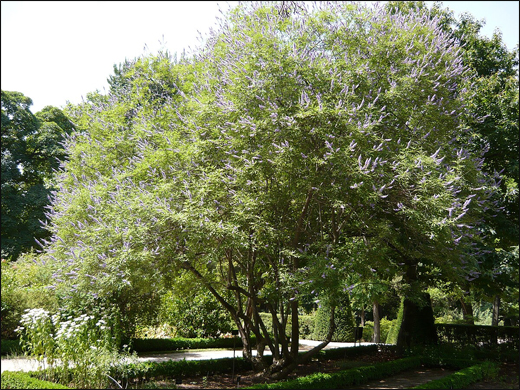Vitex agnus-castus Linn. / Chasteberry – Ayurvedic Properties, Practical Uses & Medicines
Abstract
Vitex agnus-castus Linn., commonly known as Chaste Tree or Monk’s Pepper, is a revered medicinal shrub used traditionally for its potent effects on the female reproductive system. Widely employed in both ancient and modern herbal medicine, this plant balances hormonal functions, alleviates symptoms of PMS, and supports overall reproductive health. Its seeds, leaves and extracts are used therapeutically, thanks to their diverse phytochemical profile and systemic benefits.

Introduction
Chasteberry (Vitex agnus-castus Linn.) is a valued herb in Ayurveda known for its carminative and therapeutic properties. Traditionally, it has been used to alleviate symptoms such as excessive thirst, general debility, burning sensations, and itching. It is also recognised for its ability to help detoxify the body, making it beneficial in managing mild poisoning and inflammatory conditions. The herb works by balancing the doshas, particularly calming excess Pitta and Vata. Its soothing and cooling nature makes it useful in conditions associated with heat and irritation. Additionally, it supports overall vitality and promotes a sense of physical and mental well-being.
Scientific Name
- Kingdom: Plantae
- Clade: Angiosperms
- Clade: Eudicots
- Clade: Asterids
- Genus: Vitex
- Species: Vitex agnus-castus Linn.
Synonyms
- Renuka
- Rajaputri
- Nandini
- Kapila
- Dvija
- Bhasma Gandha
- Panduputri
- Kaunti
- Harenuka
Vernacular names
- Hindi – Renuka, Renuk
- Gujarati – Harenu
- Marathi – Renuka Beej
- Arabic – Athalak
- English – Vitex, Chaste Tree
- Tamil: Nochi
- Kannada: Bile Nocchi
- Telugu: Vavili
- Malayalam: Karinochi
- German: Keuschbaum
- French: Gattilier
Habitat
Vitex agnus-castus is naturally distributed in Western Asia and parts of Southwestern Europe. It thrives particularly well in Mediterranean regions with warm climates and well-drained soils. The plant is often found growing along riverbanks, roadsides, and dry, sunny slopes in its native areas. Today, it is also cultivated in other temperate regions around the world for its medicinal value and ornamental appeal.
Morphology
Vitex agnus-castus Linn. is a small, deciduous tree or shrub known for its fragrant violet-colored flowers that bloom in clusters. The plant bears digitate leaves, typically composed of five to seven narrow, lance-shaped leaflets that are greyish-green on the underside. Its fruits are small, oval-shaped, and brown in colour when mature. The entire plant emits a pleasant aroma and is visually appealing, making it both medicinally valuable and ornamental.
Classical Categorisation
- According to Bhavaprakasha Nighantu – Karpuradi Varga
- According to Raja Nighantu – Pippalyadi Varga
- According to Dhanvantari Nighantu – Chandanadi Varga
- According to Kaiyadeva Nighantu – Aushadi Varga
Ancient Verses
रेणुका कटुका पाके तिक्ताऽनुष्णा कटुर्लघुः | पित्तला दीपनी मेध्या पाचनी गर्भपातिनी ।
बलासवातकृच्चैव तृट्कण्डूविषदाहनुत् ॥
(Bhavprakash Nighantu Karpooradi varga 106)
According to the above shloka, Renuka has a pungent taste, hot potency, and is light in nature. It increases Pitta dosha, enhances digestive fire, is effective for memory, digestive, abortifacient and increases Kapha and Vata dosha.
Ayurvedic Properties
- Taste (Rasa) – Pungent (Katu)
- Physical property (Guna) – Light (Laghu)
- Potency (Veerya) – Hot Potency (Usna)
- Post-digestion effect (Vipaka) – Katu (Pungent)
- Effect on tridosha – Increases all three doshas
Therapeutic Properties
- Trit – Excessive thirst
- Kandu – Itching
- Visha – Toxic conditions or poisoning
- Daha – Burning sensation
- Daurbalya – General weakness
- Mukha Vaimalya Karini – Cleanses and purifies the oral cavity
Systemic Actions
- Digestive System – It is effective in the management of ascites in case of Hepato-spleomegaly. It is given in the management of Hiccups, excess thirst and burning sensation.
- Nervous System – It is effective in enhancing memory.
Chemical Composition
- Vitexin
- Casticin
- Agnuside
- Aucubin
- p-Hydroxybenzoic acid
- Alkaloids
- Essential oils
- Fatty oils
- Diterpenoids
- Steroids
Modern Overview
Cytotoxic Effects
The n-hexane and methanol extracts of the fruit have demonstrated chemopreventive potential, as evidenced by their ability to induce nicotinamide adenine dinucleotide phosphate: quinone oxidoreductase type 1 (NQO1) activity and exhibit cytotoxicity against Madin–Darby Bovine Kidney (MDBK) adherent cells. Two compounds—vitetrifolin D and vitexlactam C—were identified as the key bioactive constituents responsible for these effects. Additionally, the ethanol extract of the fruit, along with its flavonoid content, particularly the major compound casticin, has shown cytotoxic activity against various cancer cell lines. These include colon carcinoma (COLO 201), gastric signet ring carcinoma (KATO-III), human uterine cervical canal fibroblasts, ovarian cancer (MCF-7), breast carcinoma (SKOV-3), human embryo fibroblasts (HE-21), cervical carcinoma (SKG-3a), small cell lung carcinoma (Lu-134-A-H), and leukemia cells (HL-60).
Antioxidant Activities
Flavonoids are among the primary chemical constituents of Vitex agnus-castus, known for their antioxidant and free radical scavenging properties. Studies have shown a positive correlation between the antioxidant activity of the plant’s extracts and their phenolic content. In one investigation evaluating the decolourisation of the radical monocation of 2,2′-azinobis-(3-ethylbenzothiazoline-6-sulfonic acid) (ABTS), ethanol, n-hexane, and water extracts from the leaves and fruits of the plant demonstrated antioxidant activity. This effect was attributed to the presence of flavonoids and tannins, with water and ethanol extracts exhibiting stronger antioxidant activity than the n-hexane extract.
Practical Uses
- Regulates Menstrual Cycles – Drink chasteberry tea daily to support hormonal balance.
- Relieves PMS Symptoms – Take chasteberry extract to ease mood swings and bloating.
- Eases Menopause Symptoms – Use chasteberry to reduce hot flashes and night sweats.
- Reduces Hormonal Acne – Consume regularly to help clear acne caused by hormonal imbalance.
- Supports Fertility – Use chasteberry under guidance to regulate ovulation.
- Relieves Breast Pain – Take chasteberry extract to ease cyclical mastalgia.
- Balances Hormones Naturally – Brew tea with chasteberry for daily hormonal support.
Part Used
- Seeds
- Leaves
- Root
Dosage
Powder – 0.5-1 gm
Ayurvedic Medicines
- Balaswagandhadi Thailam
- Bala tel
- Vasachandanadi taila
- Mahayograj Guggul
Planet Ayurveda Medicines
Conclusion
The therapeutic benefits of Vitex agnus-castus in addressing hormonal disorders such as PMS, menstrual irregularities and breast pain are well-documented and supported by regulatory bodies. Despite its potential, the herb should be avoided during pregnancy and breastfeeding due to possible hormonal interactions. Additionally, its use may interfere with dopamine-related medications. Overall, Vitex agnus-castus presents itself as a valuable herbal option in women’s health, warranting further scientific investigation to validate its long-term safety and clinical effectiveness.



